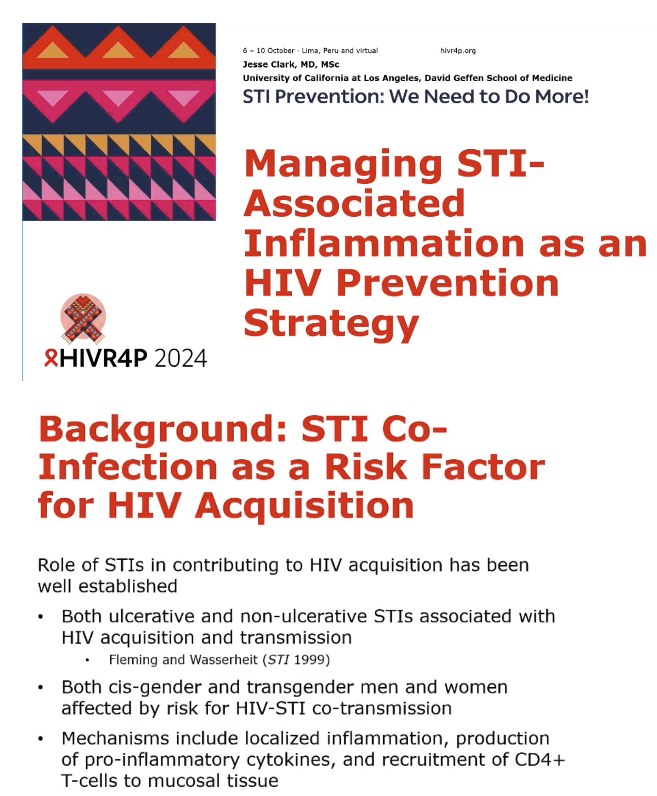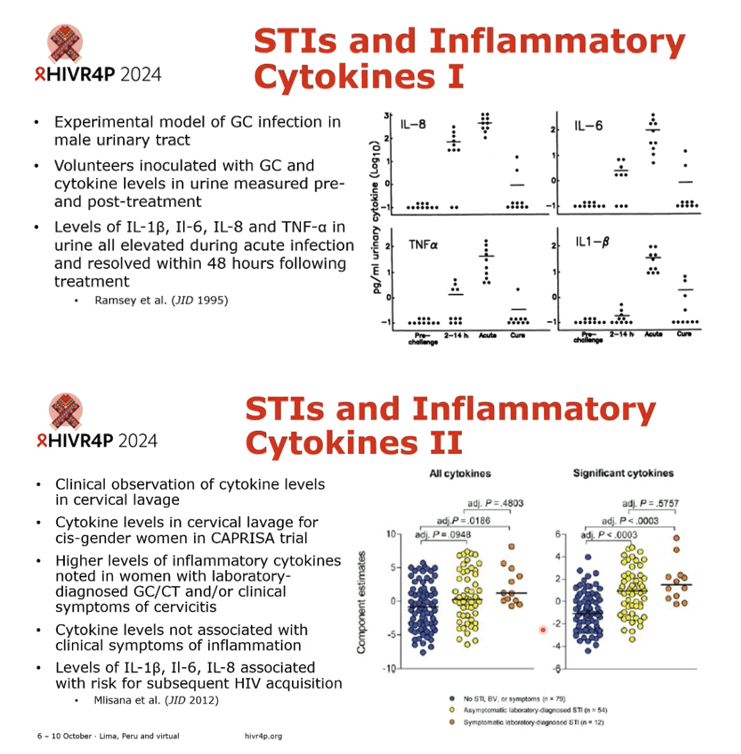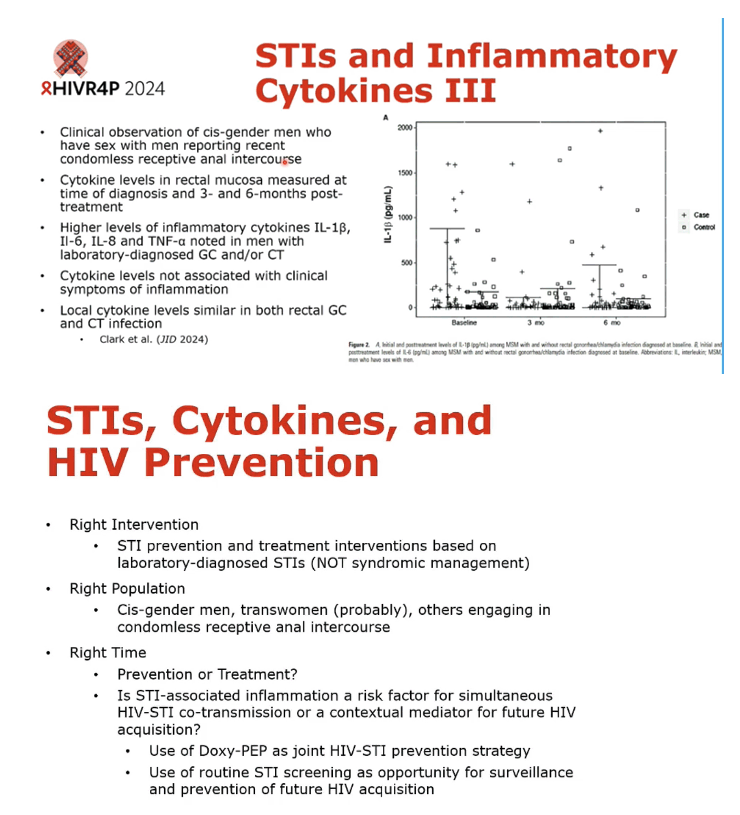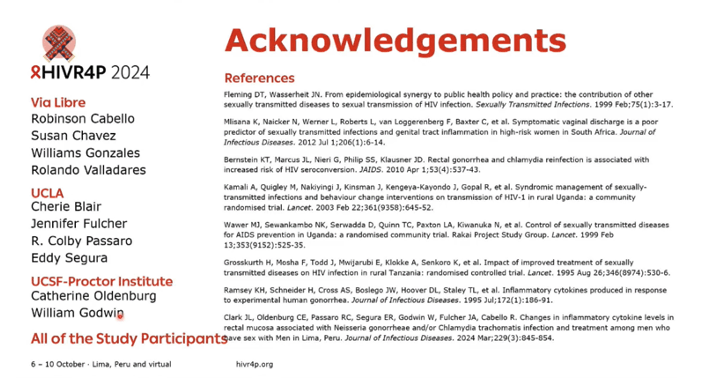 |
 |
 |
| |
Managing inflammation from STIs as an HIV prevention strategy
Can Cutting STI-Linked Inflammation Prevent HIV Infection?
|
| |
| |
HIVR4P 2024, Fifth HIV Research and Prevention Conference, October 6-10, 2024, Lima
Mark Mascolini
Jesse Clark (University of California, Los Angeles) argued in a concise analysis of published data that tamping down inflammation caused by sexually transmitted infections (STIs) can work as an HIV prevention strategy, but only in certain circumstances: The strategy must be the right intervention used in the right population at the right time [1].
Ample research shows that STIs can contribute to HIV risk, Clark reminded HIVR4P attendees. As long ago as 1999, Fleming and Wasserheit amassed data linking both ulcerative and nonulcerative STIs to acquiring and transmitting HIV [2]. Work since then established that both cisgender and transgender men and women face a greater risk of HIV and STI cotransmission. Clark listed mechanisms for the impact of STIs on acquiring or transmitting HIV as localized inflammation, production of proinflammatory cytokines, and recruitment of CD4 cells to mucosal tissue.
As epidemiologic evidence of avid STI-HIV interplay, Clark pointed to cisgender women in a CAPRISA 2-year observational cohort study in South Africa [3]. Women with gonorrhea or chlamydia ran more than a 3-fold greater risk of acquiring HIV infection during 24 months of observation than did women without those STIs (hazard ratio [HR] 3.3, 95% confidence interval [CI] 1.5 to 7.2). A retrospective look at men who have sex with men (MSM) attending a San Francisco clinic found an 8-fold higher chance of getting HIV infection if they had 2 or more bouts of rectal gonorrhea or chlamydia in the past 2 years (HR 8.2, 95% CI 2.4 to 27.8) [4].
But mixed results emerged from attempts to tie STI control to HIV prevention, Clark cautioned. The Masaka, Rakai, and Mwana trials tried to learn whether community-based STI control could curb HIV incidence [5-7]. Mwanza said yes; Masaka and Rakai said no. These diverging results, Clark proposed, suggest that STI control can prevent HIV infection only with "the right intervention with the right population at the right time."
A 1995 study analyzed the impact of STIs on inflammatory cytokines by intraurethral challenge of volunteers with Neisseria gonorrhoeae [8]. Measuring cytokine levels in urine before and after Neisseria gonorrhoeae inoculation showed higher levels of IL-1-beta, IL-6, IL-8, and TNF-alpha during acute infection and returns to normal levels within 48 hours of antibiotic therapy.
Measuring cytokine level in cervical lavage of cisgender women diagnosed with gonorrhea or chlamydia or with clinical symptoms of inflammation, CAPRISA trial researchers could not link those levels to clinical symptoms of inflammation [3]. But the study did tie higher levels of IL-1-beta, IL-6, and IL-8 to a 3-fold higher risk of HIV infection (HR 3.3, 95% CI 1.5 to 7.2).
An observational case-control study by Clark himself identified 101 cases of gonorrhea or chlamydia in cisgender MSM in Lima, Peru and matched 50 men with one of these STIs to 52 men with no STIs [9]. Measuring cytokines in rectal mucosa at STI diagnosis and 3 and 6 months after treatment, Clark's team found higher levels of the inflammatory cytokines IL-6, IL-8, and TNF-alpha in men with lab-diagnosed gonorrhea or chlamydia. But as in the CAPRISA women [3], they could not link cytokine levels to clinical symptoms of inflammation. Local cytokine levels in these Lima MSM proved similar in both rectal gonorrhea and chlamydia.
Clark summarized this work by arguing that HIV prevention by managing STI-induced inflammation depends on the right intervention (STI prevention and treatment must be based on lab-diagnosed STIs-not syndromic management) given to the right population (cisgender men, transgender women (probably), or others who have receptive anal intercourse without condoms), and given at the right time (for example, using doxycycline postexposure prophylaxis as joint HIV and STI prevention, and using routine STI screening as an opportunity for surveillance and prevention of future HIV acquisition).
References
1. Clark J. Managing inflammation from STIs as an HIV prevention strategy. HIVR4P 2024, Fifth HIV Research and Prevention Conference, October 6-10, 2024, Lima. Abstract PRC020.
2. Fleming DT, Wasserheit JN. From epidemiological synergy to public health policy and practice: the contribution of other sexually transmitted diseases to sexual transmission of HIV infection. Sex Transm Infect. 1999;75:3-17. doi: 10.1136/sti.75.1.3. https://sti.bmj.com/content/75/1/3.long
3. Mlisana K, Naicker N, Werner L, et al. Symptomatic vaginal discharge is a poor predictor of sexually transmitted infections and genital tract inflammation in high-risk women in South Africa. J Infect Dis. 2012;206:6-14. doi: 10.1093/infdis/jis298. https://pubmed.ncbi.nlm.nih.gov/22517910/
4. Bernstein KT, Marcus JL, Nieri G, Philip SS, Klausner JD. Rectal gonorrhea and chlamydia reinfection is associated with increased risk of HIV seroconversion. J Acquir Immune Defic Syndr. 2010;53:537-43. doi: 10.1097/QAI.0b013e3181c3ef29. https://journals.lww.com/jaids/abstract/2010/04010/rectal_gonorrhea_and_chlamydia_reinfection_is.16.aspx
5. Grosskurth H, Mosha F, Todd J, et al. Impact of improved treatment of sexually transmitted diseases on HIV infection in rural Tanzania: randomised controlled trial. Lancet. 1995;346:530-536. doi: 10.1016/s0140-6736(95)91380-7. https://www.thelancet.com/pdfs/journals/lancet/PIIS0140-6736(95)91380-7.pdf
6. Grosskurth H, Gray R, Hayes R, et al. Control of sexually transmitted diseases for HIV-1 prevention: understanding the implications of the Mwanza and Rakai trials. Lancet. 2000;355:1981-1987. doi: 10.1016/S0140-6736(00)02336-9. https://www.thelancet.com/journals/lancet/article/PIIS0140-6736(00)02336-9/abstract
7. Korenromp EL, White RG, Orroth KK, et al. Determinants of the impact of sexually transmitted infection treatment on prevention of HIV infection: a synthesis of evidence from the Mwanza, Rakai, and Masaka intervention trials. J Infect Dis. 2005;191 Suppl 1:S168-78. doi: 10.1086/425274. https://academic.oup.com/jid/article/191/Supplement_1/S168/933234
8. Ramsey KH, Schneider H, Cross AS, et al. Inflammatory cytokines produced in response to experimental human gonorrhea. J Infect Dis. 1995;172:186-191. doi: 10.1093/infdis/172.1.186. https://pubmed.ncbi.nlm.nih.gov/7797909/
9. Clark JL, Oldenburg CE, Passaro RC, et al. Changes in inflammatory cytokine levels in rectal mucosa associated with Neisseria gonorrheae and/or chlamydia trachomatis infection and treatment among men who have sex with men in Lima, Peru. J Infect Dis. 2024;229:845-854. doi: 10.1093/infdis/jiad349. https://www.ncbi.nlm.nih.gov/pmc/articles/PMC10938210/





|
| |
|
 |
 |
|
|